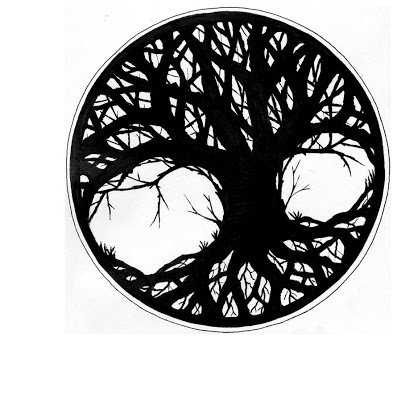Roots and Branches
“I don’t know,” I said, when it came
time for me to speak, “I guess I feel like I’m kind of drifting – as if my
practice is lacking in direction or something...” My gaze left Ginny’s face and
refocused on the tree branches outside the window just behind where she was sitting
with a small group of us. It was the third residential retreat that I’d done
with her since the breakup of my marriage and she was probably in a better
position than anybody else to know what I’d been going through. “Whenever I’ve
been here in the past,” I continued, “I’ve felt so much more focused. Maybe it’s
kind of like that tree out there. It used to be that I was like the roots – going
deeper and deeper, pushing through the soil, making my way down to where the water
is… But now I feel like that branch – just hanging there out in the open, not
really doing anything…” My eyes refocused on Ginny’s. There was nothing more
that I could say to describe what I was feeling.
“It sounds like peace,” Ginny
replied with a slight nod.
Now, having been trained in counseling
psychology, I was familiar with the reframe – taking the proverbial lemon and
pointing out the potential for great lemonade. I was also familiar with how an
inappropriate reframe can come off as shallow, treacly and dismissive of the
underlying emotion. Such a reframe can make or break a counseling relationship –
either demonstrating that the counselor has a clear grasp of the client’s situation
or revealing that he or she is uncomfortable with difficult emotion and wants
to move the conversation into Happy Land
as quickly as possible.
“Hmmph,” I grunted in
acknowledgment, and over the course of the grunt’s inception somewhere deep
inside my belly and its release into the room I came to recognize the truth
that Ginny had just revealed to me. I held my hands together in gassho and
bowed.
We often describe things in terms
of peaks and valleys, but I think that meditation practice can also be described
in terms of roots and branches. At various times either the pain of the sitting
itself, or the busyness of our minds, or the difficulty of the emotions with
which we are sitting become the soil in which our practice takes root. Almost
palpable, these phenomena provide soil against which our effort and intention might
push in order to nudge our way deeper and deeper. A little adversity can be
good in this regard. It ultimately gives our practice stability – like a tree
rooting itself deeply and solidly into the earth.
But let’s not lose track of the
other activity of the tree – holding out its branches, swaying in the breeze,
feeling the gentle rains and the warmth of the sun… Let’s not get so caught up
in ourselves and the activity of putting down roots that we mistake these
feelings of peace and wellbeing for a lack of focus or direction.
Yes, there is a time for the reassessment
of “where our practice is going,” either because we’ve gotten complacent or because
we’ve wandered away from our truest intention. But let’s also consider yet
another option: that we might just be at peace!
To study the Buddha Way is to study the
self. To study the self is to forget the self. To forget the self is to be
verified by all things. To be verified by all things is to let the body and
mind of the self and the body and mind of others drop off. There is a trace of
realization that cannot be grasped. We endlessly express this ungraspable trace
of realization. – from Dogen’s Genjokoan, as translated in Okumura (2010)
For other recollections of Ginny
Morgan, please see May Their Compassion Embrace Us.
References
Okumura, S. (2010). Realizing
genjokoan: The key to Dogen’s shobogenzo. Wisdom Publications. p.2. (Original
work published 1233)
Image Credits
Tree
of Life image courtesy of VisibleMind via:
Copyright 2013 by Mark Frank





Comments
Post a Comment